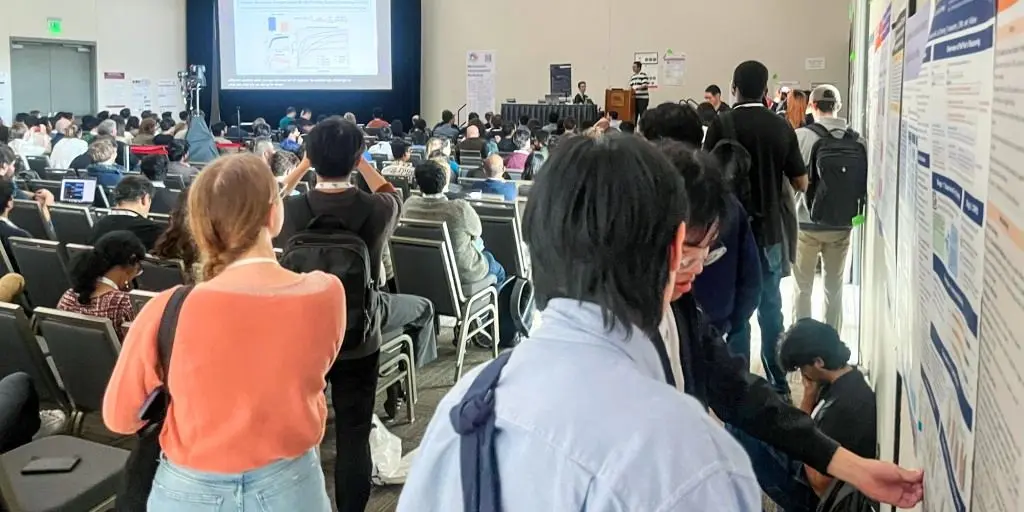AI-Driven Biological Discovery: A New Framework for Scientific Advancement
2 Sources
2 Sources
[1]
Researchers outline promises, challenges of understanding AI for biological discovery
Machine learning is a powerful tool in computational biology, enabling the analysis of a wide range of biomedical data such as genomic sequences and biological imaging. But when researchers use machine learning in computational biology, understanding model behavior remains crucial for uncovering the underlying biological mechanisms in health and disease. In a recent article in Nature Methods, researchers at Carnegie Mellon University's School of Computer Science propose guidelines that outline pitfalls and opportunities for using interpretable machine learning methods to tackle computational biology problems. The Perspectives article, "Applying Interpretable Machine Learning in Computational Biology -- Pitfalls, Recommendations and Opportunities for New Developments," is featured in the journal's August special issue on AI. "Interpretable machine learning has generated significant excitement as machine learning and artificial intelligence tools are being applied to increasingly important problems," said Ameet Talwalkar, an associate professor in CMU's Machine Learning Department (MLD). "As these models grow in complexity, there is great promise not only in developing highly predictive models but also in creating tools that help end users understand how and why these models make certain predictions. However, it is crucial to acknowledge that interpretable machine learning has yet to deliver turnkey solutions to this interpretability problem." The paper is a collaboration between doctoral students Valerie Chen in MLD and Muyu (Wendy) Yang in the Ray and Stephanie Lane Computational Biology Department. Chen's earlier work critiquing the interpretable machine learning community's lack of grounding in downstream use cases inspired the article, and the idea was developed through discussions with Yang and Jian Ma, the Ray and Stephanie Lane Professor of Computational Biology. "Our collaboration began with a deep dive into computational biology papers to survey the application of interpretable machine learning methods," Yang said. "We noticed that many applications used these methods in a somewhat ad hoc manner. Our goal with this paper was to provide guidelines for more robust and consistent use of interpretable machine learning methods in computational biology." One major pitfall the paper addresses is the reliance on a single interpretable machine learning method. Instead, the researchers recommend using multiple interpretable machine learning methods with diverse sets of hyperparameters and comparing their results to obtain a more comprehensive understanding of the model behavior and its underlying interpretations. "While some machine learning models seem to work surprisingly well, we often do not fully understand why," Ma said. "In scientific domains like biomedicine, understanding why models work is crucial for discovering fundamental biological mechanisms." The paper also warns against cherry-picking results when evaluating interpretable machine learning methods, as this can lead to incomplete or biased interpretations of scientific findings. Chen emphasized that the guidelines may have broader implications for a wider audience of researchers interested in applying interpretable machine-learning methods to their work. "We hope that machine learning researchers developing new interpretable machine learning methods and tools -- particularly those working on explaining large language models -- will carefully consider the human-centric aspects of interpretable machine learning," Chen said. "This includes understanding who their target user is and how the method will be used and evaluated." While understanding model behavior remains crucially important for scientific discovery and a fundamentally unsolved machine learning problem, the authors hope these challenges spur further interdisciplinary collaborations to facilitate the broader use of AI for scientific impact.
[2]
Quest for AI literacy - Nature Methods
Even if AI comes across as a kind of a black box, says NSF director Sethuraman Panchanathan, people will want to assess how it works on a macro level. Credit: Yagi Studio/Getty Images Putting in place verifiable, explainable AI is important, says Panchanathan. "Even if it is a black box, people want to understand: how does this black box work at a macro level?" Science thrives in an open, transparent world. Shortly after the Biden Administration's executive order on AI, the NSF and other collaborating government agencies launched the National Artificial Intelligence Research Resource (NAIRR) Pilot to build a shared research infrastructure in AI. One NAIRR-funded project is from University of Missouri computer scientist Dong Xu. He and his team develop deep learning algorithms and software for single-cell data analysis and protein-sequence-based predictions. Along with plant scientists, his team is building, validating and deploying a plant biology-specific and tuned foundation model to address specific challenges in plant-focused single-cell data analysis. Such models have been developed to analyze human single-cell data, but no similar model for plants exists, despite how much single-cell data there is, he says. "We believe this presents a unique opportunity." Part of the funding is 10,000 computing hours at the University of Illinois Urbana-Champaign's National Center for Supercomputing Applications Delta supercomputer, which has many GPU computing options and is configured for memory-intensive applications. AI is becoming ubiquitous across fields, says Xu, but settling AI into biology means more than using AI for visually appealing graphs or reasonable dialog. In science, he says, "the accuracy of AI predictions must closely align with scientific observations, ensuring reliability and reducing hallucinations." In such projects, collaboration is critical, he says, especially because biology is inherently complex and involves sophisticated mechanisms. Domain knowledge is needed, as is "a deep integration between AI and biological expertise to make real progress." One AI application he would like to explore is AI-powered instantaneous translation, says Wolfgang Huber, a researcher at the European Molecular Biology Laboratory (EMBL) who also teaches in a bilingual bioinformatics summer school for Ukrainian scientists. At EMBL, he co-organized a meeting on AI and biology and saw excitement about AI applications firsthand. In genomics, scientists see promise in such tools for learning more about enhancers or splicing processes. Among researchers setting up single-cell atlases, he sees that many want to build foundation models that contain all known cell types. With such a system, researchers hope to explore structures in these cells and establish a "grammar of cell types." When using, adapting or refining AI tools, says Huber, one should keep in mind that they are trained on material from the past and that they make mistakes. Cross-checking results with multiple LLMs would only help if the mistakes were uncorrelated. But statistically speaking, that's not the case. "There may be just inherent bias," he says. He finds AI tools very useful for retrieving information, for finding interesting patterns in data and for generating hypotheses. What then must follow is results validation, just as is the case more generally in 'omics and large-scale informatics analysis. To establish mechanism and causality takes experimental follow-up. As Huber and colleagues work on how to make AI compatible with the scientific method, they know an AI tool's results must be reproducible and understandable. In some respects, AI might be akin to less well understood areas of science such as quantum mechanics and small particle behavior. Those are where complex math is applied to behavior that is "alien to our human senses and experience." Even so, he says, "I think the standards for AI in science will be different than, let's say, for AI in movie recommendations."
Share
Share
Copy Link
Researchers have developed a new framework that outlines how artificial intelligence can be used to accelerate biological discovery. This approach could revolutionize scientific research by enhancing hypothesis generation and experimental design.

AI's Growing Role in Biological Research
In a groundbreaking development, researchers have introduced a comprehensive framework that outlines how artificial intelligence (AI) can be harnessed to accelerate biological discovery. This innovative approach, detailed in a study published in Nature Methods, promises to revolutionize the way scientists conduct research and make breakthroughs in the field of biology
1
.The Framework: Bridging AI and Biology
The newly proposed framework serves as a roadmap for integrating AI into the biological research process. It emphasizes the potential of AI to enhance various stages of scientific inquiry, from hypothesis generation to experimental design and data analysis. By leveraging machine learning algorithms and vast datasets, researchers aim to uncover patterns and insights that might otherwise remain hidden to human observers
2
.Key Components of the AI-Driven Approach
-
Data Integration: The framework emphasizes the importance of combining diverse biological datasets, including genomic, proteomic, and metabolomic information.
-
Machine Learning Models: Specialized AI models are developed to analyze complex biological systems and predict outcomes.
-
Hypothesis Generation: AI algorithms can propose novel hypotheses based on patterns identified in large-scale datasets.
-
Experimental Design Optimization: The framework suggests ways AI can help design more efficient and targeted experiments.
Potential Impact on Scientific Discovery
Researchers believe that this AI-driven approach could significantly accelerate the pace of biological discovery. By automating certain aspects of the research process and providing new analytical tools, scientists may be able to tackle more complex problems and explore previously uncharted territories in biology
1
.Related Stories
Challenges and Considerations
While the potential of AI in biological research is immense, the framework also acknowledges several challenges:
-
Data Quality and Standardization: Ensuring the reliability and compatibility of diverse biological datasets remains a significant hurdle.
-
Interpretability: As AI models become more complex, interpreting their results in a biologically meaningful way becomes increasingly important.
-
Ethical Considerations: The use of AI in biological research raises questions about data privacy, ownership, and the potential for biased outcomes.
Future Directions
The authors of the study suggest that this framework could serve as a starting point for more targeted research into AI applications in biology. They envision a future where AI becomes an integral part of the scientific process, working alongside human researchers to push the boundaries of biological knowledge
2
.As this framework gains traction, it may lead to the development of new AI tools specifically designed for biological research, potentially transforming the landscape of scientific discovery in the coming years.
References
Summarized by
Navi
[1]
[2]
Related Stories
AI in Scientific Research: Potential Benefits and Risks of Misinterpretation
05 Apr 2025•Science and Research

AI Model Predicts Gene Activity in Human Cells, Transforming Biological Research
09 Jan 2025•Science and Research

26,000 AI researchers admit they can't explain how models work as interpretability crisis deepens
09 Dec 2025•Science and Research

Recent Highlights
1
AI Chatbots Sway Voters More Effectively Than Traditional Political Ads, New Studies Reveal
Science and Research

2
OpenAI declares code red as Google's Gemini 3 gains 200 million users in three months
Technology

3
Trump approves Nvidia H200 chip exports to China with 25% revenue cut, defying Senate concerns
Policy and Regulation




